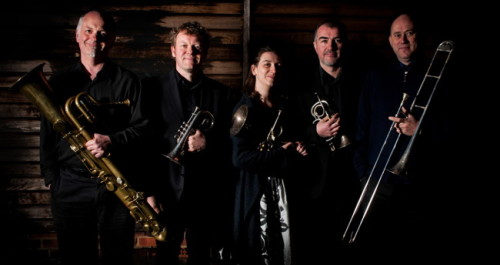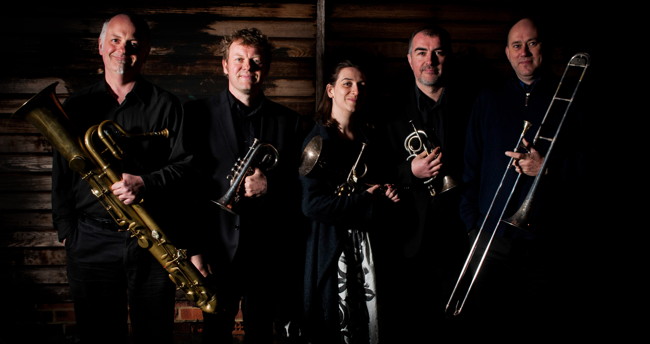 United Kingdom Ewald, Böhme, Glazunov: The Prince Regent’s Band [Fraser Tannock, Richard Thomas (trumpets and cornets), Anneke Scott (althorn and French horn), Phil Dale (baritone and trombone), Jeff Miller (tuba)]. Dora Stoutzker Hall, Royal Welsh College of Music and Drama, Cardiff, 7.11.2017. (GPu)
United Kingdom Ewald, Böhme, Glazunov: The Prince Regent’s Band [Fraser Tannock, Richard Thomas (trumpets and cornets), Anneke Scott (althorn and French horn), Phil Dale (baritone and trombone), Jeff Miller (tuba)]. Dora Stoutzker Hall, Royal Welsh College of Music and Drama, Cardiff, 7.11.2017. (GPu)

Victor Ewald (1860-1938) – Brass Quintet No.1, Op.5; Brass Quintet No.2, Op.6
Oskar Böhme (1870-1938) – Prelude and Fugue, No.1, Op.28
Alexander Glazunov (1865-1936) – Brass Quartet, Op.38 ‘In Modo Religioso’
To attend a concert by The Prince Regent’s Band is to experience a new sound-world. Or, to be more precise a lost sound-world newly rediscovered. This fine ensemble was established with the aim of exploring and recuperating the chamber music for brass (and wind) instruments written in ‘a period roughly defined as between the French Revolution of 1789 and the end of the First World War in 1918’ (quoted from the group’s website: http://www.princeregentsband.com/). This is not, of course, only a matter of repertoire, (though much interesting music from the time has fallen into relative neglect or been entirely forgotten); such an intention also raises questions of instrumentation. The sounds of, for example, the soprano cornet-à-piston in E-flat, the rotary valve trumpet in B-flat, the rotary valve althorn in E-flat, the rotary valve tenor trombone and the rotary valve bass tuba in F, are little (if at all) known to most of us these days.
What turns out to matter most, in a performance by The Prince Regent’s Band is not, however, the sounds of the individual instruments, but the beautifully blended sound produced when such instruments are played together as well as they are by this ensemble. Anneke Scott and Fraser Tannock, to name but two, are soloists with considerable international reputations, but here they are very much members of an ensemble sound.
The instrumental expertise of all the members of The Prince Regent’s Band is of the highest order. They all have experience in a number of our finest period bands. In their collective CVs ensembles such as the Orchestre Révolutionnaire et Romantique, the Orchestra of the Age of Enlightenment, the Amsterdam Baroque Ensemble and the Academy of Ancient Music appear with insistent regularity. All of this expertise and experience is put, in The Prince Regent’s Band, at the service of the kind of ensemble single-mindedness which is one of the hall marks of the finest chamber music performances.
Of the three composers whose work was played in this concert, probably only Glazunov can be said to be a generally familiar name. Viktor Ewald was born in St. Petersburg and, in addition to being a cornetist and composer (mainly for brass instruments) was also a very competent cellist and a Professor of Civil Engineering. He was a regular at the famous chamber music ‘Friday evenings’ organised by Mitrofan Petrovich Belyayev, often performing as the cellist of a string quartet (Glazunov was another regular ‘member’ of these evenings).
Born near Dresden, Oskar Böhme studied composition and trumpet (his father was also a trumpeter) at the Leipzig Conservatory; he moved to St. Petersburg in 1897. St. Petersburg was something of a magnet for top-quality brass players, music for brass being held in particularly high esteem there. This was due, in part, to the fact that the Royal Family (and many other aristocrats) were enthusiasts for such music, as both players and listeners. The Grand Duke Alexander (1845-94) was a keen cornetist himself and organized a group which met weekly to play brass chamber music. His music-making involved other Russian nobility, as well as the bandmasters of the various bands of guards. Böhme initially worked for many years in the orchestra of the Marinsky Theatre, taught and later played in the orchestra of the Leningrad Drama Theatre. His career was eventually destroyed, however, in the years of Stalin’s ‘Great Purge’. In 1934 he was exiled, essentially just because of his Germanic origins, to Orenburg, south east of Moscow on the traditional boundary between Europe and Asia. He seems to have been shot there in October 1938.
It was Ewald’s music which we heard first (and indeed last) in this concert, and from the first bars of the Moderato which opened his Quintet No.1 (Opus 5) one found oneself in the embrace of a warm yet crisp sound (quite without traditional ‘brassiness’). Here was an experience of a remarkable ‘organic’ relationship between specific instruments and particular music. I have heard several recordings (and concert performances) of this Quintet on modern instruments, but hearing this performance gave the music a remarkable freshness, like a first glimpse of an aged picture after the accumulations of varnish and other accretions had been removed. The two B-flat cornets, the althorn in E-flat, the tenorhorn in B-flat and the rotary valve bass tuba in F made a ravishing sound which exuded comfort and warmth, with intonation utterly perfect, dynamics shifting sensitively. The blend of smoothness and sharpness was remarkable and deeply satisfying. In these opening bars the tuba of Jeff Miller seemed to be the very ‘ground’ out of which everything else grew. In the Adagio which followed, the interplay of the two cornets was another fresh delight, and in the closing Allegro moderato the subtle shifts of tempo were wholly engaging. This performance made me realize that Ewald’s music was far more sophisticated than I had previously recognized. This was the only one of Ewald’s Quintets to be published during his lifetime (by the aforementioned Belyayev in 1912). Manuscripts of three other Brass Quintets came to light in the 1960s; modern editions of these have been published, but in a form incorporating changes to make them more readily suitable for performance by modern-instrument ensembles. However, in a rare treat, this concert programme closed with a performance of Ewald’s Quintet No.2 (Opus 6), the manuscript of which The Prince Regent’s Band traced to the library of the St. Petersburg Philharmonic. This was the source ‘text’ for the PRB’s performance of the work, enabling it to be heard in a manner much closer to that envisaged by the composer. The opening Allegro risoluto contains some witty phrasing and mild rhythmic surprises; the central Thema con Variationi has both charm and (relatively) grave thoughtfulness, while the closing Allegro vivace delights, not least by its impish opening. Like the Quintet which opened the playing, this rediscovered work, given the scholarly and perceptive advocacy of The Prince Regent’s Band revealed new depths to Ewald’s music.
Between these two substantial works by Ewald, The Prince Regent’s Band played two briefer compositions by Oskar Böhme and Alexander Glazunov. One was the first of the Zwei Dreistimme Fugen (Op. 28) by Böhme, published in 1904. This was reflective and well-made music, with the Fugue involving some elegant interweaving of instrumental voices and an attractive sense of space. The short work (it weighs in at a little over four minutes) by Glazunov was originally written for Brass Quartet (1886) and was later republished in a transcription for piano (1893). If one has heard the Quartet version performed on modern instruments, however competent and perceptive such performances were, to hear it on ‘original’ instruments is to encounter what sounds like a new work. Its title, ‘In Modo Religioso’, sounds more apt, its dignity more genuine and unforced, its timbres more simply beautiful.
In short, an hour-long concert full of delight, instruction and illumination. It was only a shame that it was heard by a relatively small audience.
Glyn Pursglove
